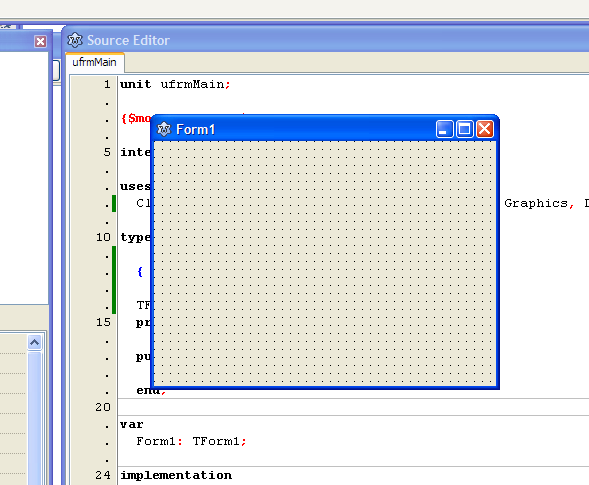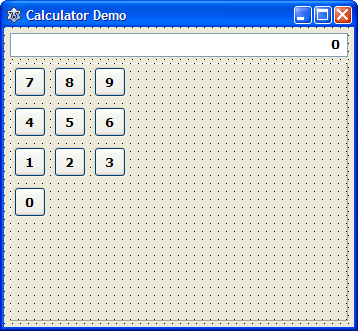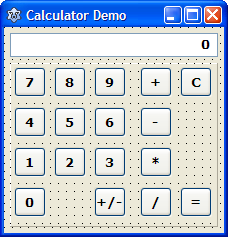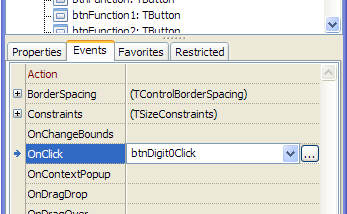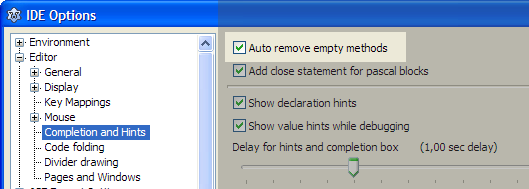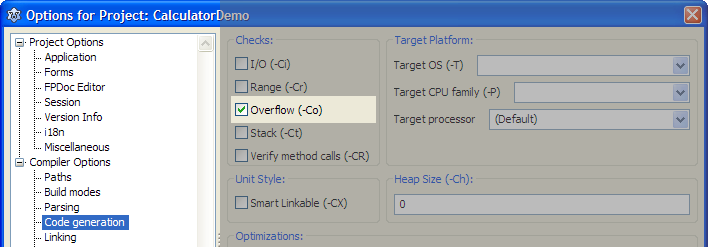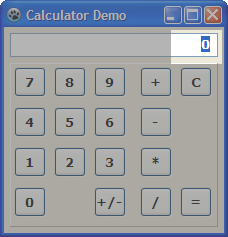Howdy World (Hello World on steroids)/pt
Este capítulo é um tutorial para Lazarus. Ele explica os primeiros passos para obter um software funcional e também algumas das melhores práticas. O resultado final (esperado) é duplo: o leitor entende os conceitos básicos para construir um software com Lazarus e obtém um verdadeiro programa funcional. Uma calculadora é algo razoavelmente fácil de implementar e todo mundo entende seus conceitos, sem necessidade de explicações de antemão. A calculadora é limitada a cálculos com números inteiros, mas pode facilmente ser estendida.
Este tutorial não descreve o processo de instalação do Lazarus. Ele assume que o Lazarus está instalado e pronto para uso (preferivelmente a última versão estável, que no momento é a 0.9.30 com FreePascal 2.4.2). Este tutorial é mais ou menos independente de plataforma. Todos os screenshots foram feitos em Windows XP, portanto com o esquema de cores azul/vermelho/cinza.
Leitura recomendada antes de começar: uma introdução abrangente da Lazarus IDE.
Vamos começar
É melhor criar um diretório separado para cada projeto. Portanto, vamos criar um diretório para salvar o projeto da nossa Calculadora. Este diretório será a raiz de todos os arquivos criados para o projeto.
- Criar um novo diretório para o projeto de demonstração (digamos, $HOME/CalculatorDemo).
(Texto que descreve ações que precisam ser executadas é marcado, como a linha anterior)
Com isto resolvido, é hora de iniciar um novo projeto Lazarus.
- Inicie o Lazarus.
- Escolha Projeto/Novo Projeto… do menu.
- Na caixa de diálogo que é apresentada selecione Aplicação e pressione OK (if the IDE reclama sobre modificações não salvas, pressione Não).
Para ter certeza de que todos os arquivos do nosso novo projeto estarão no diretório certo, o projeto precisa ser salvo primeiro.
- Do menu, escolha Arquivo/Salvar Tudo.
- Selecione o diretório que foi criado previamente ($HOME/CalculatorDemo).
- Insira um novo nome de projeto: CalculatorDemo.
- Pressione Salvar (ou o que corresponder a isto em seu idioma).
- A IDE quer salvar o formulário principal também: insira ’’ufrmMain’’ como o nome da unidade do formulário.
- A IDE pergunta se o nome do arquivo deve ser modificado para minúsculas. Confirme isto pressionando o botão 'Renomear para minúsculas'.
Em teoria, o programa que é assim criado é um software válido que pode ser executado. Antes de compilá-lo pela primeira vez, duas modificações são recomendadas: atribuição de novos locais (diretórios) para as unidades de destino e nome do arquivo compilado.
- Do menu, escolha Projeto/Opções de Projeto.
- Selecione Opções do Compilador/Caminhos (clique no nó da TreeView).
- Insira o texto ‘‘bin\’‘ antes do nome de arquivo alvo (ou ‘‘bin/’‘ ´para ambientes *nix).
- Note também o prefixo ‘‘lib’‘ para ‘diretório de saída das unidades’ (não o modifique).
- Pressione OK.
A imagem abaixo mostra como isto ficaria em uma máquina Windows.

Fazendo isto, a pasta do projeto não será desordenada com a saída gerada pelo compilador. Os arquivos da pasta do projeto são necessárias para construir o programa. Tudo nos diretórios ’’lib’’ e ’’bin’’ podem ser eliminados quando do arquivamento do projeto.
Agora, como um primeiro teste, o projeto pode ser compilado e executado.
- Pressione F9 (o atalho para compilar, construir e executar o programa). Se tudo sair bem, uma tela em branco será mostrada. Agora sabemos que foi criada uma base sólida sobre a qual podemos começar a construir o programa.
- Finalize a execução clicando no ícone Fechar (isto depende do OS).
O primeiro componente
O Lazarus tem uma assim chamada 'paleta de componentes':
Todos os componentes que estão disponíveis para construir uma interface do usuário estão logicamente agrupados nas abas de componentes. O número real de abas depende dos pacotes instalados, mas a paleta básica se parece com a imagem acima. A primeira aba é a Standard, seguida pela Aditional, Common controls, etc.
Para retornar o nome do tipo de um componente, passe o mouse sobre o ícone do componente e um aviso será mostrado (mais precisamente, o nome de classe do componente). Para uma explanação sobre todos os controles, veja esta Lazarus introduction
A primeira coisa que é preciso ser feita para o programa de Calculadora é criar uma área de display, onde estão os números. Para isto, um controle TEdit é usado.
# Nota: os componentes visuais são referidos como Controles. Para o nosso propósito, a diferença entre um "componente" e um "controle" não é relevante.
Para colocar um controle no formulário, este precisa ter o foco. Pressionar F12 no teclado muda o foco do editor de formulários para o editor de código e vice-versa.
- Pressione F12 uma vez ou duas para posicionar a janela do formulário no topo (veja imagem abaixo).
- Selecione a aba Standard na palete de componentes. Esta é a aba que é selecionada por padrão.
- Clique sobre o componente TEdit (passe o mouse sobre os ícones de componentes para obter os nomes de classe).
- Clique em algum lugar no formulário. Isto colocará um controle TEdit no formulário com um nome que é o mesmo nome da classe do componente sem a letra "T" e com um número no final (por exemplo, Edit1). Quando um segunto TEdit for colocado no formulário, será nomeado como Edit2, e assim por diante. Isto se aplica a todos os componentes.
Agora que o controle está colocado no formulário, ele pode ser personalizado como você precisar. Esta personalização tem lugar no Inspetor de Objetos. Esta é a janela à esquerda da tela, com a lista de propriedades para o controle TEdit que são personalizáveis.
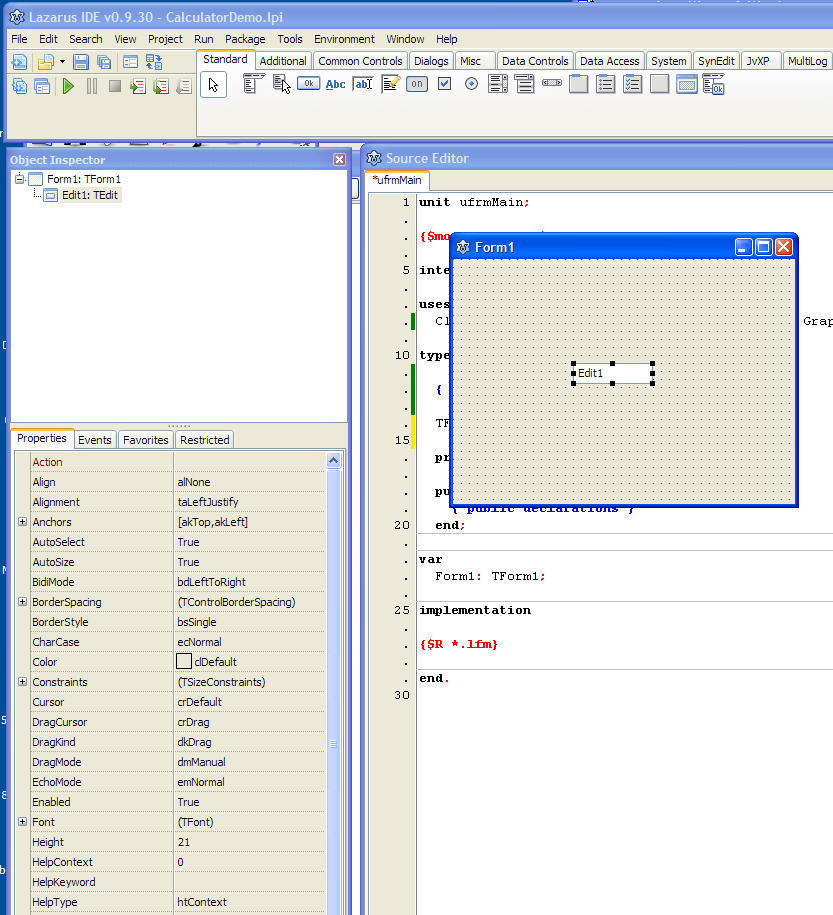
As propriedades determinam a aparência e o comportamento do controle. É fácil modificá-las: apenas clique em uma delas, insira um novo valor e pressione Enter. O efeito no controle é imediatamente visível. As propriedades no Inspetor de Objetos são todas propriedades para um único controle, particularmente o controle que tem o foco ou está selecionado. Portanto, a maneira de modificar propriedades de um controle é primeiramente selecioná-lo e então fazer as modificações no Inspetor de Objetos. Se nenhum controle for selecionado, as propriedades do formulário serão mostradas.
Faça as seguintes modificações nas propriedades de Edit1:
- Mude o nome para edDisplay.
- Mude Align para alTop (não confundir com Alignment).
- Mude Alignment para alRightJustify (não confundir com Align).
- Mude BorderSpacing.Around para 6.
- Mude Text para 0 (o número zero, não a letra "O").
Estas propriedades são bastante autoexplicativas, especialmente quando as modificações acima são feitas e o efeito é monitorado no formulário.
Como um toque final, a fonte que é usada para mostrar textos em todos os controles será mudada. A fonte pode ser mudada de duas maneiras: na propriedade Font de edDisplay ou na mesma propriedade do formulário. Mudando a fonte do formulário tem o benefício de que todos os componentes anteriormente criados 'herdarão' a nova fonte, e é aí que nós faremos a nossa modificação.
- Clique em algum lugar do formulário. Isto desselecionará o controle edDisplay e selecionará o próprio formulário. As propriedades do formulário são agora mostradas no Inspetor de Objetos.
- No Inspetor de Objetos, clique na propriedade Font. A linha da propriedade Font será realçada e um botão com três pontos será mostrado.
- Clique no botão com três pontos. Isto abre a caixa de diálogo Fonts.
- Selecione Verdana, Bold, Tamanho 10.
- Pressione OK.
O título do formulário não é muito significativo. O padrão é 'Form1'.
- No Inspetor de Objetos, clique na propriedade Caption.
- Mude o texto para Calculator Demo.
O resultado de todas estas ações será um formulário que se parece com este:
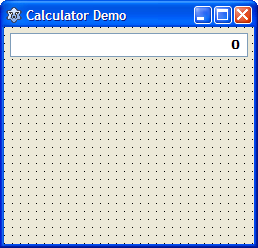
Agora é uma boa hora para salvar o formulário.
- Selecione do menu Arquivo/Salvar ou pressione a combinação de teclas Ctrl+S.
Lembre-se de salvá-lo e o salve com frequência!
Botões
Para que serve uma calculadora se não puderem ser inseridos números? Portanto o próximo passo será adicionar botões para os dígitos 0..9. Antes de posicionar os botões para os dígitos, um assim chamado "contêiner" é colocado no formulário. Um TPanel é outro contêiner que podem ser colocados no formulário. Contêineres podem ser colocados dentro de outros, mas isto é para outro tutorial.
- Na paleta de componentes, selecione um controle TPanel.
- Clique no formulário para criar o painel. Um novo painel está agora visível no formulário com largura, altura e rótulo padronizados. Note que a fonte do painel é herdade do formulário. Este painel será usado para agrupar todos os botões, então algumas propriedades devem ser modificadas.
- Remova o texto Panel1 da propriedade Caption.
- Modifique Align par a alClient.
- Modifique Borderspacing.Around para 6.
- Aumente a largura (width) do formulário para 300 (primeiro clique no formulário na TreeView do Inspetor de Objetos).
- Aumente a altura (height) do formulário para 350.
(Aumentando o tamanho do formulário nos dará algum espaço para mover os controles.)
Agora os botões dos dígitos serão adicionados.
- Na paleta de componentes, selecione um controle TButton.
- Clique no formulário para posicioná-lo. O botão é colocado no painel. Isto é visível no Inspetor de Objetos: Button1 é chamado filho (child) de Panel1. Isto efetivamente significa que, se o painel for movido, todos os controles filhos serão movidos, e quando Panel1 for eliminado, todos os controles-filhos o serão também.
- No Inspetor de Objetos, modifique o valor de Caption para 0 (o número zero).
- Modifique a largura (width) para 32.
- Modifique a altura (height) para 30 .
- Modifique o nome (name) para btnDigit0.
This must be repeated for the digits 1..9. The quickest way to do this is by copy/pasting the 0-button.
- Right click on the button created above and select Copy from the pop up menu.
- Right click somewhere else on Panel1 and select Paste; a second button is added to the panel. The only difference with the first button is the name btnDigit1.
- change the Caption property in the Object Inspector to 1
- repeat the Paste action 8 more times for the remaining buttons.
- Move the buttons around on the form to get a lay out that looks like a calculator:
Next are the four buttons for the mathematical functions (add, subtract etc.).
- Drop a new TButton on the panel.
- Change Width to 32.
- Change Height to 30 .
- Change Caption to +
- Change Name to btnFunction.
- Copy/paste this button 3 more times, changing the caption to -, * and /.
- Align the buttons vertically, right next to the digit buttons
And the 'special' buttons:
- Copy/Paste the + button.
- Change Caption to +/-.
- Change Name to btnPlusMinus .
- Position the button just below button 3.
- Copy/Paste the + button.
- Change Caption to C.
- Change Name to btnClear.
- Position the button to the right of button +.
- Copy/Paste the + button.
- Change Caption to =.
- Change Name to btnCalculate .
- Position the button to the right of button /
Not what all buttons are placed, resize the form to fit the buttons tightly.
It should look something like this:
Remember to save and save often!
Responding to events
A gui application (often) is an event based application. This means that the application does nothing until we tell it to do something. For example by entering data via the keyboard, pressing buttons etc. One of the things the calculator needs to do is responding to mouse clicks on the buttons 0..9. This is where the IDE helps us. Adding a so called event handler for a button is easy.
- Make sure the form with all buttons is visible (if necessary press F12 once or twice).
- Double click on the button with caption 0: the IDE automatically creates a procedure that will handle mouse clicks: procedure TForm1.btnDigit0Click(Sender: TObject);
- type the following code between begin and end:
<Delphi>edDisplay.Text := edDisplay.Text + '0'</Delphi> edDisplay is an edit box. The way to change the contents of the edit box is by modifying the Text property. The above statement adds the number '0' to the text in the edit box and this is visible on screen immediately.
- Double click on the button with caption 1.
- type the following code between begin and end:
<Delphi>edDisplay.Text := edDisplay.Text + '1'</Delphi>
It's a good idea to compile the code from time to time to check for syntax errors.
- Select from the menu: Run/Run (or press F9); the project is compiled and the application starts.
- Click the digits 0 and 1 a couple of times and see what happens on screen. The other buttons do nothing obviously because the event handlers have not yet been added.
- Stop the Calculator Demo program.
Of course it's now easy to add event handlers for the digits 2..9, but this will result in a lot of redundant code. Every event handler does exactly the same, only the digit is different. The way to remove this redundancy is by creating a procedure that does the processing, and add the variable data (the digits 0..9) as a parameter.
- In the editor locate the lines where class TForm1 is declared. It will look something like this:
<Delphi> { TForm1 }
TForm1 = class(TForm)
btnDigit0: TButton;
btnDigit1: TButton;
btnDigit2: TButton;
btnDigit3: TButton;
btnDigit4: TButton;
btnDigit5: TButton;
btnDigit6: TButton;
btnDigit7: TButton;
btnDigit8: TButton;
btnDigit9: TButton;
btnFunction: TButton;
btnFunction1: TButton;
btnFunction2: TButton;
btnFunction3: TButton;
btnCalculate: TButton;
btnPlusMinus: TButton;
btnClear: TButton;
edDisplay: TEdit;
Panel1: TPanel;
procedure btnDigit0Click(Sender: TObject);
procedure btnDigit1Click(Sender: TObject);
private
{ private declarations }
public
{ public declarations }
end; </Delphi>
Note that in the above class definition all controls and procedures are declared that we added to the form via 'pointing-and-clicking'. Do not make any manual changes in there!! The IDE will get nervous when you do. The place to add custom variables, procedures and functions is in the private or public sections. As a general rule all custom variables are added to the the private section. Procedures and functions are added to the private section as well, except when other forms need to call these procedures or functions (which shouldn't happen too often).
Back to our digits problem: we need a procedure that adds digits to the display, where the digits themselves can vary.
- Add procedure AddDigit to the private section of the form.
<Delphi> private
{ private declarations }
procedure AddDigit(const pDigit: byte);
public
{ public declarations }
end; </Delphi>
Next the actual code of the AddDigit procedure must be entered. Again the IDE comes to the rescue:
- Place the blinking text cursor on the AddDigit line.
- Press key combination Ctrl-Shift-C.
The IDE generates the definition of this new method and places the text cursor inside the empty body. We can immediately start typing.
- Add the following code to the AddDigit procedure body:
<Delphi>edDisplay.Text := edDisplay.Text + IntToStr(pDigit)</Delphi> Note that function IntToStr() translates a numerical value, the digit, to a string value so it can be added to the display text.
Now to use this procedure for all digits 0..9:
- Open the form (if necessary press F12 once or twice).
- Double click on digit button 0: this will open the editor in the event handler for button 0.
- Replace the code in the event handler with: AddDigit(0). The procedure will look like this:
<Delphi>procedure TForm1.btnDigit0Click(Sender: TObject); begin
AddDigit(0)
end;</Delphi>
- Do the same for digit button 1:
<Delphi>procedure TForm1.btnDigit1Click(Sender: TObject); begin
AddDigit(1)
end;</Delphi>
Before completing this sequence for all other digit buttons, make sure that this actually does what we want.
- Run the program (press F9).
- Click buttons 0 and 1 a couple of times and see that it actually works.
- End the program.
A good programmer is a lazy programmer
Now we can add event handlers to digit buttons 2..9. But then again we have the same problem of creating a lot of redundant code: AddDigit(2), AddDigit(3) etc. What if there were a way to tell the buttons apart? Luckily there is.
All components have an integer property called Tag (remember: a control is just a special kind of component that inherits this Tag property). It is a property that has no actual function. It is there for us to use as we see fit. Now what if each button would have it's digit value stored in the Tag property…
- Open the form (if necessary press F12 once or twice).
- Select digit button 1 (click on it once).
- In the Object Inspector locate the Tag property and change it's value to 1.
- Select digit button 2 (click on it once).
- In the Object Inspector locate the Tag property and change it's value to 2.
- Repeat this for digit buttons 3..9.
Now all digit buttons have a unique Tag value. We didn't change digit button 0 because the default Tag value already is 0. Now to make use if this Tag value:
- Open the form.
- Double click on digit button 0 (this will open the editor in the event handler of digit button 0).
- Note that procedure btnDigit0Click has a parameter Sender of type TObject.
<Delphi>procedure TForm1.btnDigit0Click(Sender: TObject);</Delphi> The Sender parameter is actually a reference to the button that was pressed. Via typecasting we can use the parameter as if it was a TButton.
- Change the code like this:
<Delphi>procedure TForm1.btnDigit0Click(Sender: TObject); begin
AddDigit(TButton(Sender).Tag)
end;</Delphi>
It doesn't look like we have accomplished much, replacing one line of code with another. However if we were to add the code for the other digits (1..9) it would look exactly the same. So all other digits can reuse this particular method!
Let's have a closer look at the Object Inspector.
- Open the form.
- Select digit button 0 (btnDigit0).
- In the Object Inspector select tab Events (see below).
In the object inspector we can not only change the properties of a control but also the event handlers. In the Object Inspector we can see that as soon as digit button 0 is clicked, method btnDigit0Click is called (this is the OnClick event handler).
- On the form: select digit button 2. In the Object Inspector we can now see that there is no OnClick event handler for button 2.
- Open the drop down list for the OnClick event and select btnDigit0Click.
- Do this for all other digit buttons 3..9.
Now all buttons share one common procedure that does exactly what we want except for digit button 1. Remember that for digit button 1 we created an event handler btnDigit1Click that we don't really need anymore.
- On the form: select digit button 1. In the Object Inspector we can now see that the event handler indeed is btnDigit1Click.
- Open the drop down list for the OnClick event and select btnDigit0Click.
Now all buttons share the same event handler to add digits to the display box.
- Run the program (press F9).
- Click all buttons 0..9 a couple of times and see that it actually works.
- End the program.
For the digit buttons one final thing needs to be done: event handler btnDigit1Click still exists but is not used anymore and should be deleted. The safest way to do this (for now) is to let the IDE handle it. For this to work the option Auto remove empty methods must be enabled.
- In the menu select Environment/Options.
- Click on Editor/Completion and Hints.
- Enable the option 'Auto remove empty methods' (see image below).
- Press OK.
From now on all empty methods are automatically deleted as soon as the source file is saved.
- Locate method procedure TForm1.btnDigit1Click(Sender: TObject)
- Delete the line 'AddDigit(1)'
- Save the file (press Ctrl-S or select from the menu File/Save). The now empty procedure is automatically deleted.
Tuning
So far so good: the calculator program compiles, runs and responds to clicks on digit buttons 0..9. But it doesn't behave exactly as we want: there's always this annoying zero at the beginning of the number and the number of allowed digits is too large.
Removing leading zeroes
Normally an integer number that's bigger (or smaller) than zero does not start with a leading zero. So our calculator should compensate for this. Luckily this is easy to implement. Remember that we have one and only one method that handles the addition of digits: AddDigit. This is the place to add logic to suppress the leading zero.
- Locate method procedure TForm1.AddDigit(const pDigit: byte)
- Change the code to:
<Delphi>procedure TForm1.AddDigit(const pDigit: byte); begin
// Suppress leading zeroes when adding digits if edDisplay.Text = '0' then edDisplay.Text := IntToStr(pDigit) else edDisplay.Text := edDisplay.Text + IntToStr(pDigit)
end;</Delphi>
Limit the number of digits
This demo calculator cannot handle numbers that are too large. So we need to limit the number of digits that can be entered. Again the logical place to do this is the AddDigit method:
- Locate method procedure TForm1.AddDigit(const pDigit: byte)
- Change the code to:
<Delphi>procedure TForm1.AddDigit(const pDigit: byte); begin
// Limit the number of digits
if length(edDisplay.Text) < 8 then
begin
// Suppress leading zeroes when adding digits
if edDisplay.Text = '0' then
edDisplay.Text := IntToStr(pDigit)
else
edDisplay.Text := edDisplay.Text + IntToStr(pDigit)
end;
end; </Delphi>
Operations
Now it's time to look at the actual operations we want to implement: adding, subtracting, multiplying and dividing. The way the user is going to use the calculator goes something like this:
- The user enters a number
- The user presses a function button (e.g. '+')
- The user enters a second number
- The user presses '='
- The program responds with the addition of the first and second number
As soon as the user presses the '=' button the program has to know three things:
- What was the operation?
- What was the first number?
- What was the second number?
What was the operation?
Somehow we need to register that a certain operation type was selected. And for that we need to know what operation types are available. One way to implement this is to create an enumeration type (or user defined scalar type) that contains all valid operations.
- In the Source Editor, find the location where the form is declared.
- Just above the form add the type declaration TOperationType for all supported operations:
<Delphi> type
{ All supported operations for our calculator }
TOperationType = (otNone, otPlus, otMinus, otMultiply, otDivide);
{ TForm1 }
TForm1 = class(TForm)</Delphi>
- To temporarily store the operation, a variable is added to the private section of the form's class declaration.
<Delphi> private
{ private declarations }
SelectedOperation: TOperationType;
procedure AddDigit(const pDigit: byte);</Delphi>
What was the first number?
To temporarily store the first number that was entered we need a variable.
- Add a variable to the form's private section.
<Delphi> private
{ private declarations }
SelectedOperation: TOperationType;
FirstNumber: longint;
procedure AddDigit(const pDigit: byte);</Delphi>
What was the second number?
- Add variable SecondNumber to the form's private section (the same as FirstNumber) and make it a longint as well.
What's on your mind
Now it's time to implement the actions for the function buttons: add, subtract, multiply and divide. Let's start with the '+' button. As mentioned in one of the previous sections: when the '+' button is pressed, we need to store the first number and the operation type. So that's what we are going to do.
- Open the form.
- Double click on button '+'. The IDE creates an event handler and the text cursor is placed inside the empty begin/end block.
Hold on! Before adding all the code here and doing the same for the three other operation buttons, remember what was said when the digit buttons 0..9 were added: do not add redundant code! It's reasonable to assume that the code for the other three operation buttons will be the same as for the '+' button, except for the operation itself. So let's save ourselves some work.
- Locate the form's private section and add a new procedure: StoreOperation.
<Delphi> private
{ private declarations }
SelectedOperation: TOperationType;
FirstNumber: longint;
SecondNumber: longint;
procedure AddDigit(const pDigit: byte);
procedure StoreOperation(const pOperation: TOperationType);</Delphi>
- Place the blinking text cursor on the newly inserted line.
- Press Ctrl-Shift-C (you know the drill by now…).
The StoreOperation procedure must do two things: store the operation and store the number that was entered in the display, so it can be used afterwards.
- Add the following code to the newly created procedure:
<Delphi>procedure TForm1.StoreOperation(const pOperation: TOperationType); begin
// Store the operation so it can be used later SelectedOperation := pOperation;
// Store the number that was entered by the user FirstNumber := StrToInt(edDisplay.Text);
end;</Delphi>
Ok, now back to the '+' button:
- Open the form.
- Double click on button '+'.
- Add the following code: StoreOperation(otPlus);
- Open the form.
- Double click on button '-'.
- Add the following code: StoreOperation(otMinus);
- Open the form.
- Double click on button '*'.
- Add the following code: StoreOperation(otMultiply);
- Open the form.
- Double click on button '/'.
- Add the following code: StoreOperation(otDivide);
Now test the program and see what happens:
- Run the program (press F9)
- Enter a number (e.g. 21267)
- Press the '+' button
- Enter the second number (e.g. 31170)
What happens is that after pressing the '+' button, or any other operation button for that matter, the display is not cleared. We must find a way to make sure that the display is cleared, as soon as an operation button is pressed. Because we have used procedures to group similar actions, this again is an easy change.
- Locate the form's private section and add a new variable: doClearDisplay. This variable will be the trigger for erasing the display.
<Delphi> private
{ private declarations }
SelectedOperation: TOperationType;
FirstNumber: longint;
SecondNumber: longint;
doClearDisplay: boolean;
procedure AddDigit(const pDigit: byte);
procedure StoreOperation(const pOperation: TOperationType);</Delphi>
- Position the blinking text cursor on the line StoreOperation.
- Press Ctrl-Shift-CursorDown: this moves the cursor to the body of the StoreOperation procedure.
- In the StoreOperation procedure we must update the doClearDisplay variable, so we know that the display must be cleared as soon as a new number is entered. Change the code to this:
<Delphi>procedure TForm1.StoreOperation(const pOperation: TOperationType); begin
// Store the operation so it can be used later SelectedOperation := pOperation;
// Store the number that was entered by the user FirstNumber := StrToInt(edDisplay.Text);
// The display must start with a new number doClearDisplay := true;
end;</Delphi>
- And where better to clear the display than in the AddDigit procedure? Change the code to:
<Delphi>procedure TForm1.AddDigit(const pDigit: byte); begin
// Must the display be cleared first? if doClearDisplay then begin edDisplay.Text := '0'; // Reset the display to zero doClearDisplay := false; // Once is enough... end;
// Limit the number of digits
if length(edDisplay.Text) < 8 then
begin
// Suppress leading zeroes when adding digits
if edDisplay.Text = '0' then
edDisplay.Text := IntToStr(pDigit)
else
edDisplay.Text := edDisplay.Text + IntToStr(pDigit)
end;
end;</Delphi>
Now let's see what happens:
- Run the program (press F9).
- Enter a number.
- Press an operation button.
- Enter another number.
- End the program.
We're almost there: we can enter numbers and select an operation. Now it's time to do the actual calculations.
Doing the math
Now that we have stored a number and an operation, it's time to do the actual calculations. Let's start easy with additions.
- Open the form.
- Double click on button '=' (the event handler is created).
- Change the procedure:
<Delphi>procedure TForm1.btnCalculateClick(Sender: TObject); var result: longint; begin
case SelectedOperation of
otPlus: begin
// Retrieve the second number
SecondNumber := StrToInt(edDisplay.Text);
// Do the math
result := FirstNumber + SecondNumber;
// Display the resulting value
edDisplay.Text := IntToStr(result);
end;
end;
end;</Delphi> The above code is pretty straightforward: if the user presses the '+' button, the first and second number are added up and the result is stored in the edit control on screen.
We now have a working calculator (that can only add two numbers):
- Run the program (press F9).
- Enter a number.
- Press '+'
- Enter another number.
- Press '=' : the sum of the two numbers is displayed.
- End the program.
We now could add the 3 missing operations ('-', '*' and '/'). But hold on, there is room for improvement. Let's have a look at the following statement: <Delphi>SecondNumber := StrToInt(edDisplay.Text);</Delphi> We have seen such a statement before: the StoreOperation procedure contains something similar: <Delphi>FirstNumber := StrToInt(edDisplay.Text);</Delphi> Calculating the number the user entered now happens in two different locations. We do not want to repeat ourselves so it's a good idea to create a new function that does the calculation.
- Locate the form's private section and add a new function: GetDisplayValue.
<Delphi> private
{ private declarations }
SelectedOperation: TOperationType;
FirstNumber: longint;
SecondNumber: longint;
doClearDisplay: boolean;
procedure AddDigit(const pDigit: byte);
procedure StoreOperation(const pOperation: TOperationType);
function GetDisplayValue: longint;</Delphi>
- Position the blinking text cursor on the line GetDisplayValue.
- Press Ctrl-Shift-C.
- Add this code to extract the value that is in the display field:
<Delphi>function TForm1.GetDisplayValue: longint; begin
result := StrToInt(edDisplay.Text);
end;</Delphi>
- Locate the statement: FirstNumber := StrToInt(edDisplay.Text);
- Change it to: FirstNumber := GetDisplayValue;
So much for refactoring, back to the calculations.
- Locate the statement: SecondNumber := StrToInt(edDisplay.Text);
- Change it to: SecondNumber := GetDisplayValue;
Now look at the following statements: <Delphi> // Retrieve the second number
SecondNumber := GetDisplayValue;
// Do the math
result := FirstNumber + SecondNumber;</Delphi>
Variable SecondNumber is used to store the value in the display box. However it is not really necessary. The above code can be simplified: <Delphi> // Do the math
result := FirstNumber + GetDisplayValue;</Delphi>
Now look at the following statements: <Delphi> // Do the math
result := FirstNumber + GetDisplayValue;
// Display the resulting value
edDisplay.Text := IntToStr(result);</Delphi>
The same now applies to the result variable. The above code can be simplified to: <Delphi> // Display the resulting value
edDisplay.Text := IntToStr(FirstNumber + GetDisplayValue);</Delphi>
Now we can add the 3 remaining operations.
- Open the form.
- Double click on button '=' (the event handler is created).
- Change the code:
<Delphi>procedure TForm1.btnCalculateClick(Sender: TObject); begin
case SelectedOperation of otPlus : edDisplay.Text := IntToStr(FirstNumber + GetDisplayValue); otMinus : edDisplay.Text := IntToStr(FirstNumber - GetDisplayValue); otMultiply : edDisplay.Text := IntToStr(FirstNumber * GetDisplayValue); otDivide : edDisplay.Text := IntToStr(FirstNumber div GetDisplayValue); end;
end;</Delphi>
We now have a working calculator for all 4 operations:
- Run the program (press F9).
- Enter a number.
- Press an operation button.
- Enter another number.
- Press '=' : the result is displayed.
- End the program.
Intermezzo
After all this work we now have a useable calculator. But some things are not quite right. The obvious thing to try is dividing a number by zero. And the buttons 'C' and '+/-' don't work yet. These things will be addressed in the next section.
First let's add another procedure, just for the fun of it (well, there's more to it of course:-)):
- Locate the form's private section and add a new procedure: SetDisplayValue.
<Delphi> private
{ private declarations }
SelectedOperation: TOperationType;
FirstNumber: longint;
SecondNumber: longint;
doClearDisplay: boolean;
procedure AddDigit(const pDigit: byte);
procedure StoreOperation(const pOperation: TOperationType);
function GetDisplayValue: longint;
procedure SetDisplayValue(const pValue: longint);</Delphi>
- Position the blinking text cursor on the line SetDisplayValue.
- Press Ctrl-Shift-C.
- Add the code below to give the display a new value, as the procedure name suggests:
<Delphi>procedure TForm1.SetDisplayValue(const pValue: longint); begin
edDisplay.Text := IntToStr(pValue);
end;</Delphi>
The above code should look pretty familiar. Have a look at the procedure that does all calculations: <Delphi>procedure TForm1.btnCalculateClick(Sender: TObject); begin
case SelectedOperation of otPlus : edDisplay.Text := IntToStr(FirstNumber + GetDisplayValue); otMinus : edDisplay.Text := IntToStr(FirstNumber - GetDisplayValue); otMultiply : edDisplay.Text := IntToStr(FirstNumber * GetDisplayValue); otDivide : edDisplay.Text := IntToStr(FirstNumber div GetDisplayValue); end;
end;</Delphi> This procedure can now be simplified.
- Change the code to:
<Delphi>procedure TForm1.btnCalculateClick(Sender: TObject); begin
case SelectedOperation of otPlus : SetDisplayValue(FirstNumber + GetDisplayValue); otMinus : SetDisplayValue(FirstNumber - GetDisplayValue); otMultiply : SetDisplayValue(FirstNumber * GetDisplayValue); otDivide : SetDisplayValue(FirstNumber div GetDisplayValue); end;
end;</Delphi>
Loose ends
There's a couple of things that need to be done: implement the two loose buttons and make the calculator a bit more robust.
The +/- button
- Open the form.
- Double click on button '+/-' (the event handler is created).
- Add the following code:
<Delphi>procedure TForm1.btnPlusMinusClick(Sender: TObject); begin
SetDisplayValue(0 - GetDisplayValue);
end;</Delphi> See here the fruits of our labor. We have reused the procedure SetDisplayValue and GetDisplayValue to implement the negate function.
Try it by running the program and press the '+/-' button.
The Clear button
- Open the form.
- Double click on button 'C' (the event handler is created).
- Add the following code:
<Delphi>procedure TForm1.btnClearClick(Sender: TObject); begin
SetDisplayValue(0); // Start from scratch SelectedOperation := otNone; // No operation selected yet doClearDisplay := false; // The display is already cleared
end;</Delphi> The above code is pretty self-explanatory: the display is cleared (the first line), we 'forget' about any pending operation by clearing the SelectedOperation variable and there is no need to clear the display when adding new digits, because it was already cleared by the first statement.
Divide by zero
Let's go crazy: run the application and try to divide 10 by 0. This will make the application crash horribly. We have to make sure that this will not happen. The place to check this of course is the place where all calculations are performed (TForm1.btnCalculateClick).
- Open the form.
- Double click on button '='.
- Update the otDivide section:
<Delphi>procedure TForm1.btnCalculateClick(Sender: TObject); begin
case SelectedOperation of
otPlus : SetDisplayValue(FirstNumber + GetDisplayValue);
otMinus : SetDisplayValue(FirstNumber - GetDisplayValue);
otMultiply : SetDisplayValue(FirstNumber * GetDisplayValue);
otDivide : if GetDisplayValue <> 0 then
SetDisplayValue(FirstNumber div GetDisplayValue)
else
begin
// Display an error message to the user
MessageDlg('It is not possible to divide a number by 0!', mtWarning, [mbCancel],0);
// Reset the calculator to start with a clean slate
btnClearClick(nil);
end
end;
end;</Delphi>
Things noteworthy:
- MessageDlg is a function for displaying a short warning/error/informative message to the user. ShowMessage can also be used. It is a bit easier to use but cannot display warning/error icons.
- btnClearClick(nil): as soon as an error condition occurs we must reset the calculator. That's basically the same as pressing the 'C' button. We simulate pressing the 'C' button by directly calling the event handler.
Overflows
- Start the calculator
- Enter 99999999 as the first number (8 digits)
- Press button '*'
- Enter 99999999 as the second number
- Press button '='
Now two things could have happened:
- The application gives an incorrect result (something like 1674919425).
- The application raises an error.
If it's the first option then overflow errors have been disabled for the project. Enable them by ticking the Overflow option box:
- Select from the menu Project/Project Options…
- Select in the treeview Compiler Options/Code Generation.
- Tick the box Overflow (-Co) (see image below).
- Click OK.
Now run the program again and see what happens with overflows.
If it was the second (and expected) option then this means we have to add exception handling to our little calculator. Exception handling is used to prevent an application from crashing when errors occur. In our case we want to handle the arithmetic overflow error that might occur. Because all calculations are done in one place, it's easy to catch any overflow errors.
- Open the form.
- Double click on button '='.
- Change the code in the procedure to this:
<Delphi>procedure TForm1.btnCalculateClick(Sender: TObject); begin
// Catch any overflow errors
try
case SelectedOperation of
otPlus : SetDisplayValue(FirstNumber + GetDisplayValue);
otMinus : SetDisplayValue(FirstNumber - GetDisplayValue);
otMultiply : SetDisplayValue(FirstNumber * GetDisplayValue);
otDivide : if GetDisplayValue <> 0 then
SetDisplayValue(FirstNumber div GetDisplayValue)
else
begin
// Display an error message to the user
MessageDlg('It is not possible to divide a number by 0!', mtWarning, [mbCancel],0);
// Reset the calculator to start with a clean slate
btnClearClick(nil);
end
end;
except
on E: EIntOverflow do
begin
// Display an error message
MessageDlg('The result of the calculation was too big for the calculator to process!', mtWarning, [mbCancel], 0);
// Reset the calculator
btnClearClick(nil);
end
end
end;</Delphi>
Note that even with the exception handling in place, the application will still halt when run from inside the IDE. However the application is only paused and still active. Press F9 to continue. This will display another pop up window, a debugger notification window. Press Continue. Now our own exception handler will kick in with the expected message. If you were to run the application stand alone (i.e. outside the IDE) then you would only see the message box that we added to the exception handler.
Final tweaks
Remember that at a certain point a variable called SecondNumber was introduced. If you choose Run/Build All from the menu, then after building the application the compiler will display a message in the Messages window that this particular variable is never used. If you click on the message text the IDE opens the exact location in the editor where the variable is declared.
- Click on message Note: Private field "TForm1.SecondNumber" is never used.
- Delete longint variable SecondNumber.
As soon as our demo Calculator is started we see that the number 0 in the display has the focus (see image below).
This is counter intuitive because a user should not be able to enter anything in that box. Even worse as soon as she would type something in there that is not a number, our calculator would crash! So it's better not to give access to the that control at all. We are going to fix that.
- Open the form.
- Select the display control (click on edDisplay).
- In the Object Inspector change ReadOnly to True (if the Events tab is still visible, select the Properties tab first to gain access to all properties). From now on it's impossible to enter any data manually.
- Change TabStop to False. Now it's impossible to get to the display field via the keyboard and the display field will not be highlighted anymore.
Run the program to see the result of these changes.
(Under construction: OO-ify the program)

